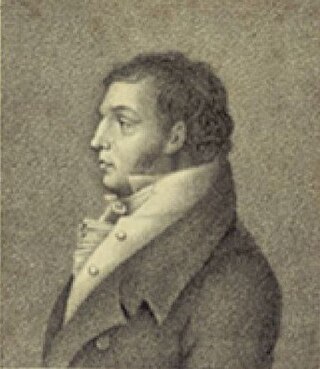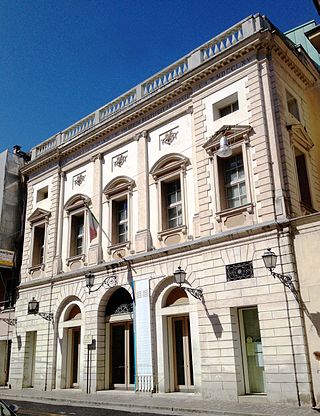
Luigi Ricci, was an Italian composer, particularly of operas. He was the elder brother of Federico Ricci, with whom he collaborated on several works. He was also a conductor.

Luca Ronconi was an Italian actor, theatre director, and opera director.
Scott Gibbons is an American-born composer and performer of electroacoustic music. His work is notable for its rigorous use of single and unexpected objects as sole instrumentation. Gibbons has also created many works for large-scale spectacle with Groupe F to accompany fireworks, which embraces the sound of pyrotechnics as a part of the musical arrangement.

Roberto Abbado is an Italian opera and symphonic music conductor. Currently he is Artistic Partner of The Saint Paul Chamber Orchestra. In 2015 he has been appointed music director of Palau de les Arts Reina Sofia in Valencia, Spain. From 2018 he's Music Director of the Festival Verdi in Parma. Previously he held the position of Chief Conductor of Münchner Rundfunkorchester.
Giorgio Bàrberi Squarotti was an Italian academic, literary critic and poet. He taught at the University of Turin from 1967 until his death in 2017. He was considered to be one of the most important literary critics of his time.

Clorinda Corradi was an Italian opera singer and one of the most famous contraltos in history.
F.I.S.Co. was an international festival that showcases examples of the convergence taking place across the contemporary arts. F.I.S.Co. was conceived and created by Xing a cultural network based in Bologna.

Antonio Cagnoni was an Italian composer. Primarily known for his twenty operas, his work is characterized by his use of leitmotifs and moderately dissonant harmonies. In addition to writing music for the stage, he composed a modest amount of sacred music, most notably a Requiem in 1888. He also contributed the third movement, Quid sum miser, to the Messa per Rossini, a collaborative work created by thirteen composers to honor Gioacchino Rossini.

Nino Machaidze is a Georgian operatic soprano. She performs in 19th-century Romantic repertoire, primarily in operas by Rossini and Verdi as well as French operas. Beginning her career at La Scala, she gained international attention after being cast as Juliette in Gounod's Roméo et Juliette at the 2008 Salzburg Festival, after which she earned the nickname "Angelina Jolie of Opera" from the Austrian press.
The Theaterfestival Spielart is an international theatre festival which takes place every two years during November and December in Munich, starting in 1995. The festival lasts between 15 and 17 days. Guests usually include over 20 international theater and performance groups.
Stephen Medcalf is a British stage director, particularly known for his opera productions, both in the UK and abroad. He received the Italian music critics' prize, Premio Abbiati, for "Best Director" in 2005. Medcalf is married to the British soprano Susan Gritton.
Giampaolo Coral was an Italian composer.
Vincenzo Galli was an Italian opera singer and impresario. Considered an outstanding basso buffo singer, he created many roles on Italian stages, including in two of Donizetti's operas: Ivano in Otto mesi in due ore and Cesare Salzapariglia in Le convenienze ed inconvenienze teatrali. Luigi Ricci composed the role of Michelotto in his opera Chiara di Rosembergh specifically for Galli's voice.
The Socìetas Raffaello Sanzio (SRS) is an Italian experiential theater company founded in 1981. Its initial development was part of movement in Italian theater which did not require a background in theater but was influenced by rock, poetry, comics, television and more. By the end of the 1990s, the work done by this group had influenced a number of newer groups, winning awards for various works. The performances of this company shuns conventional coherent narrative and focuses more on visual and auditory impact, using silences, word fragments and even animals and machines as performers. The company is based in Cesena, near Bologna, Italy where it has its own theater, but it has performed in various venues in Europe, Asia, Oceana, and the Americas.

Alan Read is a writer and professor of theatre at King's College London. Read is known as a theatre theorist and cultural activist, with scholarly interests in ethics and the everyday, performed communities, event architecture, and subjectivities of capitalism. Read's work stands as a critique of modernist theatrical orthodoxy critically contesting Peter Brook's idealism of the ‘empty space' awaiting its theatre, a tabula rasa for professionals to enter and exit at will. Read counter intuitively perceives theatre to have been superseded in that populated place by the quotidian performances of everyday life, those that remain for good and ill. Read took up this provocative critique on the National Theatre stage in London in 1994 in public dialogue with Brook's space-designer Jean-Guy Lecat, and joins others in his scepticism of the colonial fantasy of theatre's ‘empty space', including most assertively Rustom Bharucha in Theatre & The World (1993).

Eliodoro Bianchi was an Italian operatic tenor and later a prominent singing teacher. Born in Cividate al Piano and trained in Naples under Giacomo Tritto, he made his stage debut in 1793. Amongst the many roles, he created during the course of his 40-year career were Baldassare in Ciro in Babilonia and the King of Sweden in Eduardo e Cristina, both of which were composed by Rossini expressly for Bianchi's voice. He retired from the stage in 1835 and spent his later years in Palazzolo sull'Oglio, where he died at the age of 75.

The Teatro Mario Del Monaco is an opera house and theatre in Treviso, Italy. It was previously known as the Teatro Onigo from 1692 to 1846, the Teatro Sociale from 1847 to 1930, and the Teatro Comunale from 1931 to 2011. In 2011, it was renamed in honour of the Italian tenor Mario Del Monaco who lived in Treviso from 1975 until his death in 1982. It is located in the historic centre of the city on the Corso del Popolo and since 2019 has been run by the Teatro Stabile del Veneto which also runs the Teatro Goldoni in Venice and the Teatro Verdi in Padua.

Marco Filibeck is an Italian lighting designer.
Pippo Delbono is an Italian author, actor, and director.
Savino Monelli was an Italian tenor prominent in the opera houses of Italy from 1806 until 1830. Amongst the numerous roles he created in world premieres were Giannetto in Rossini's La gazza ladra, Enrico in Donizetti's L'ajo nell'imbarazzo and Nadir in Pacini's La schiava in Bagdad. He was born in Fermo where he initially studied music. After leaving the stage, he retired to Fermo and died there five years later at the age of 52.











